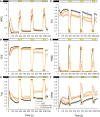Distinct contribution of two cyclic electron transport pathways to P700 oxidation
- PMID: 36477622
- PMCID: PMC10152692
- DOI: 10.1093/plphys/kiac557
Distinct contribution of two cyclic electron transport pathways to P700 oxidation
Abstract
Cyclic electron transport (CET) around Photosystem I (PSI) acidifies the thylakoid lumen and downregulates electron transport at the cytochrome b6f complex. This photosynthetic control is essential for oxidizing special pair chlorophylls (P700) of PSI for PSI photoprotection. In addition, CET depending on the PROTON GRADIENT REGULATION 5 (PGR5) protein oxidizes P700 by moving a pool of electrons from the acceptor side of PSI to the plastoquinone pool. This model of the acceptor-side regulation was proposed on the basis of the phenotype of the Arabidopsis (Arabidopsis thaliana) pgr5-1 mutant expressing Chlamydomonas (Chlamydomonas reinhardtii) plastid terminal oxidase (CrPTOX2). In this study, we extended the research including the Arabidopsis chlororespiratory reduction 2-2 (crr2-2) mutant defective in another CET pathway depending on the chloroplast NADH dehydrogenase-like (NDH) complex. Although the introduction of CrPTOX2 did not complement the defect in the acceptor-side regulation by PGR5, the function of the NDH complex was complemented except for its reverse reaction during the induction of photosynthesis. We evaluated the impact of CrPTOX2 under fluctuating light intensity in the wild-type, pgr5-1 and crr2-2 backgrounds. In the high-light period, both PGR5- and NDH-dependent CET were involved in the induction of photosynthetic control, whereas PGR5-dependent CET preferentially contributed to the acceptor-side regulation. On the contrary, the NDH complex probably contributed to the acceptor-side regulation in the low-light period but not in the high-light period. We evaluated the sensitivity of PSI to fluctuating light and clarified that acceptor-side regulation was necessary for PSI photoprotection by oxidizing P700 under high light.
© American Society of Plant Biologists 2022. All rights reserved. For permissions, please e-mail: journals.permissions@oup.com.
Conflict of interest statement
Conflict of interest statement. The authors declare no conflicts of interest associated with this manuscript.
Figures








Comment in
-
A tale of two CETs: Untangling cyclic electron transfer.Plant Physiol. 2023 May 2;192(1):7-9. doi: 10.1093/plphys/kiad088. Plant Physiol. 2023. PMID: 36787230 Free PMC article. No abstract available.
References
-
- Allahverdiyeva Y, Suorsa M, Tikkanen M, Aro E-M (2014) Photoprotection of photosystems in fluctuating light intensities. J Exp Bot 66(9): 2427–2436 - PubMed
Publication types
MeSH terms
Substances
LinkOut - more resources
Full Text Sources
Molecular Biology Databases

